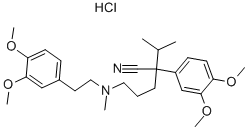| (+/-)-Verapamilhydrochloride |
|
| (CAS 152-11-4) |
 |
| Description: |
Verapamil Hcl is an L-type calcium channel blocker of the phenylalkylamine class.
IC50 Value: 0.246 ±0.013 uM (Cardiac L-Type Calcium Channel)
Target: L-type calcium channel
It has been used in the treatment of hypertension, angina pectoris, cardiac arrhythmia, and most recently, cluster headaches.
in vitro: In the K562/ADR cellline, addition of verapamil to the culture medium (15 microM concentration) resulted in a 3-fold decrease in Pgp expression after 72 hr exposure . The combination of bortezomib and verapamil synergistically decreased the viability of myeloma cells by inducing cell death. Importantly, bortezomib-mediated activation of major UPR components was enhanced by verapamil. The combination of bortezomib and verapamilresulted in caspase activation followed by poly(ADP-ribose) polymerase cleavage, whereas nuclear factor kappaB (NF-kappaB) activity declined in myeloma cells .
in vivo: Pretreatment with cadmium plusverapamil produced significant additive effects on ketamine-induced anesthesia (40.88 +/- 2.98 vs 70.32 +/- 4.64 min) . In the acute stage (17 days after infection with maximal parasitemia), verapamil treatment not only decreased the incidence of myocardial disease (fibrosis and inflammation), but also protected myocardial beta-adrenergic adenylate cyclase activity. In addition, there was no increase in total body weight, which was regarded as an index of right-sided heart failure. In the subacute stage (30 to 60 days after infection), administration of verapamil continued to decrease myocardial disease and preserve beta-adrenergic adenylate cyclase activity .
Toxicity: The majority of reported fatal cases of verapamil toxicity are due to massive, intentional overdoses. In spite of the low dose ingested, the postmortem cardiac blood verapamil level was clearly toxic (6000 ng/mL, or 6 mg/L)
|
| Product No. |
KT20595 |
| Product Name |
(+/-)-Verapamilhydrochloride |
| Synonyms |
|
| Formal Name |
|
| CAS Number |
152-11-4 |
| Molecular Formula |
C27H39ClN2O4 |
| Formula Weight |
491.06 |
| Formulation |
A crystalline solid |
| Purity |
98%min |
| Stability |
2 years |
| Storage |
-20°C |
| Shipping |
USD45 for Europe and USA. No shipping charge once amount reach USD500 |
| Quality Control |
HNMR,CNMR,LCMS,HPLC,IR,etc. |
| Price & Availability |
In Stock. Price Negotiated. |
|
| Related Products: |
Acetylcholine chloride Acetylcholine is a neurotransmitter that can induce the opening of calcium channels.
Target: Calcium Channel; nAChR; mAChR
Acetylcholine in vertebrates is the major transmitter at neuromuscular junctions, autonomic ganglia, parasympathetic effector junctions, a subset of sympathetic effector junctions, and at many sites in the central nervous system. It is generally not used as an administered drug because it is broken down very rapidly by cholinesterases, but it is useful in some ophthalmological applications.
Acetylcholine chloride, more commonly referred to as just acetylcholine, is a cholinergic neurotransmitter that can induce the opening of calcium channels, as well as act on nicotinic and muscarinic acetylcholine receptors. Acetylcholine plays an important role at many sites in the central nervous system. The compound has been shown to have ophthalmological uses and can be broken down quickly by choliesterases. Studies show that non-neuronal acetylcholine influences many basic cells functions, such as mitosis, cells differentiation, cytoskeletal organization, and cell to cell contact, among other functions [1-3].
|
|


